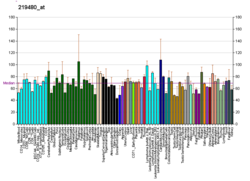SNAI1
gène de l'espèce Homo sapiens
Le SNAI1 (appelé aussi snail ou snail1) est un facteur de transcription à doigt de zinc. Son gène est le SNAI1 situé sur le chromosome 20 humain.
Rôles
modifierIl réprime l'expression des claudines et des occludines intervenant dans les jonctions serrées au niveau de la transition épithélium-mésenchyme[5], ce qui constitue une autre voie d'action que celle de la cadhérine E [6].
En médecine
modifierPlusieurs germes permettent l'activation de cette protéine entraînant une perméabilité de la barrière hémato-encéphalique[7].
Notes et références
modifier- GRCh38: Ensembl release 89: ENSG00000124216 - Ensembl, May 2017
- GRCm38: Ensembl release 89: ENSMUSG00000042821 - Ensembl, May 2017
- « Publications PubMed pour l'Homme », sur National Center for Biotechnology Information, U.S. National Library of Medicine
- « Publications PubMed pour la Souris », sur National Center for Biotechnology Information, U.S. National Library of Medicine
- Ikenouchi J, Matsuda M, Furuse M, Tsukita S, Regulation of tight junctions during the epithelium-mesenchyme transition: direct repression of the gene expression of claudins/occludin by Snail, J Cell Sci, 2003;116:1959–1967
- Ohkubo T, Ozawa M, The transcription factor Snail downregulates the tight junction components independently of E-cadherin downregulation, J Cell Sci, 2004;117:1675–1685
- Kim BJ, Hancock BM, Bermudez A et al. Bacterial induction of Snail1 contributes to blood-brain barrier disruption, J Clin Invest, 2015;125:2473-2483





